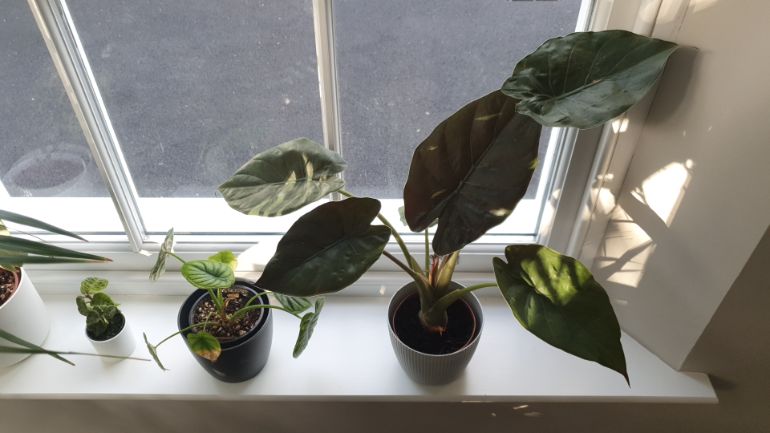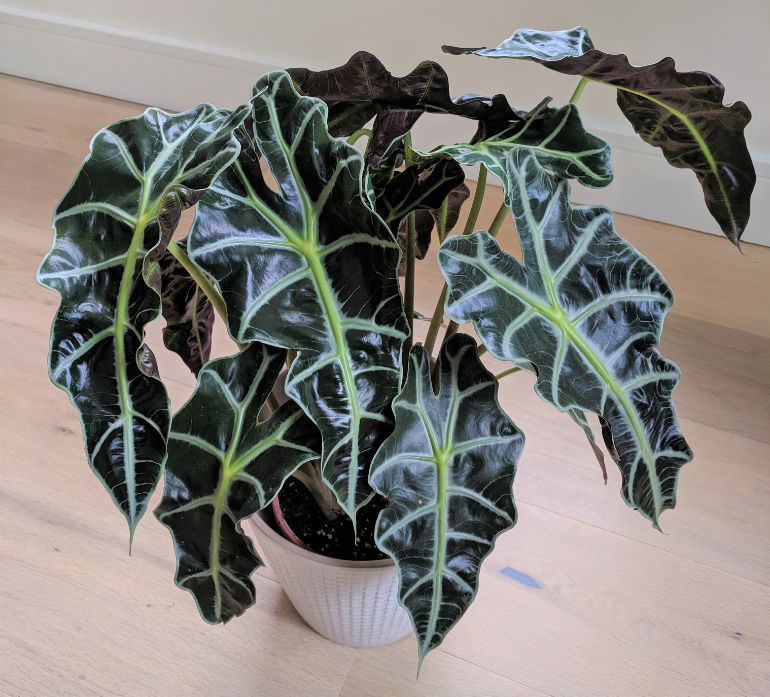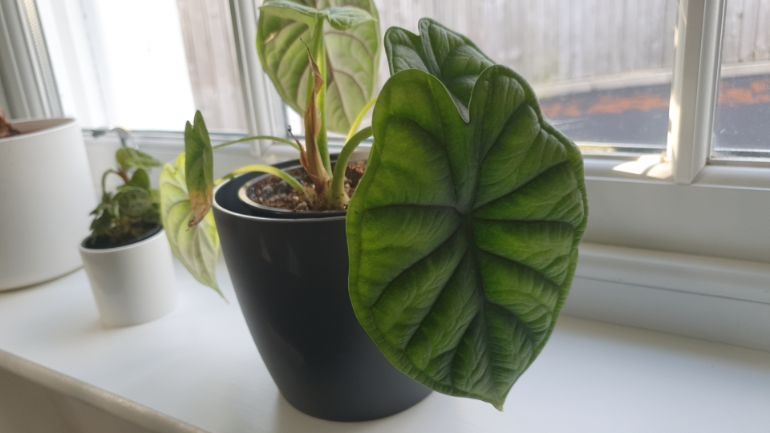Alocasias bring exuberant tropical ambiance to our homes … and then one day the music stops and the plant begins to wither and decline. Don’t toss it out – it’s probably just going to sleep! Let’s unravel the mystery of Alocasia dormancy to see why it happens and how it can be managed.
Alocasia dormancy is when the plant stops growing and either stagnates or dies back. It is a natural process, triggered by a reduction in light, cooler temperatures, and drier air and soil. It will regrow when warm, bright, moist conditions return. Dormancy can be delayed or induced.
What Is Dormancy?
Dormancy in Alocasias is natural and, though unsightly, is nothing to worry about. Most plants go through some form of dormancy – it’s just that Alocasias can take it to extremes.
Visually, it looks like the plant isn’t doing anything … but that’s not the case! The plant is switching to a new phase of activity at a lower metabolic rate. Even in cold temperatures, the roots can be storing energy, converting starches, and laying the foundation for future leaves and flowers.
Some plants take their break in the heat of summer, but most – including Alocasias – become dormant in response to cold temperatures and lower light.
Winter dormancy is about efficiency: Alocasias produce leaves when it’s warm and bright and slow down when growing conditions diminish. Often they simply stop growing, but they can perform a dying act that puts a diva to shame: drooping as the leaves turn yellow one by one as they slowly die. Curtains. (Until next season.)
Why Does Your Alocasia Go Dormant?
Your Alocasia enters dormancy because it detects winter coming, whether or not that is actually true. Its broad, sun-soaking leaves are too much to sustain during the “off-season,” so it starts boarding things up.
Several factors prompt your Alocasia to go dormant:
- Shorter hours and less intense light kick off the process.
- Colder temperatures below 60°F/15°C can initiate dormancy if sustained over a week or more. (The plant can shrug off a very brief cool spell.)
- Less humid air is typical of colder weather and plays a minor role in starting dormancy.
- A drop in soil moisture is also part of the cold season, though a drier mix won’t necessarily spur dormancy on its own.
Overall, if your Alocasia doesn’t receive these signals it doesn’t go dormant. In our warm, well-lit homes, the plants often remain evergreen. They may informally power down but avoid dying back.
Note that dormancy doesn’t harm the plant and may actually be a healthy, needed cycle. Sometimes a plant will simply switch off at some point, regardless of conditions.

What Alocasia Dormancy Looks Like
There is a spectrum of dormancy: Alocasias adjust their response according to environmental signals. In a climate-controlled setting, such as inside our homes, Alocasias may not enter visible dormancy at all.
It’s important to recognize signs of dormancy in order to care for the plant properly:
- Indoor Alocasias often stop growing in the fall in response to light and temperature changes. They develop dull, droopy leaves that don’t quite die. The plant will quickly perk up when growth conditions improve.
- An Alocasia entering full-blown dormancy will die back completely, leaving only the bare pot with a tuber inside. This can happen if the plant is sitting by a window and experiences seasonal light changes and cooler windowsill temperatures. Dry, heated air also affects their decision.
Dead Or Alive: How To Identify A Dormant Alocasia
Many growers, forewarned about the difficulty of Alocasias, assume the worst and throw the hapless prima donna into the trash – not realizing it’s only dormant. (Then next year finds someone wondering about an exotic leaf poking up from the landfill.)
Don’t let this be you! If your Alocasia dies back, inspect the roots before recommissioning its pot:
- A dead Alocasia’s roots will wither into rotten mush or become desiccated and brittle.
- A dormant plant leaves behind a firm, sweet-smelling tuber just waiting for its cue to re-emerge.
How To Care For A Dormant Alocasia
It’s important to recognize when your Alocasia is dormant to give it the right care.
Here are the basics:
Reduce Watering – If your Alocasia has stopped growing, the first priority is to cut back on watering. The plant’s consumption will be less and you don’t want them sitting in wet soil. Rot pathogens are certainly not going dormant.
Keep the medium a bit drier overall during dormancy. Let the topsoil dry further down before rewatering, and don’t flush the pot with repeated inundations as usually recommended. The goal is to keep the roots just barely moist; a sip of water every two or three weeks is average.
Reduce Light – A dormant plant also uses less light, so shelter them from intense illumination. Use judgment, though: if the plant still has leaves, cutting back on light can trigger full-out dormancy.
Maintain Cool Conditions – Cool temperatures are normal in dormancy, so it’s best not to subject a dormant plant to unseasonable warmth. You don’t need to go to extremes, but be sure to keep the plant from hot appliances or drafts.
Monitor For Pests – Hungry bugs can take advantage of a dormant Alocasia, especially in warmer temperatures. Inspect the plant routinely and treat any infestation immediately. Use gentle, less toxic treatments like a dilute alcohol spray, horticultural oils, or insecticidal soap.
Alocasia Bulb Care
If your Alocasia has gone “Full Monty” and now exists only as a bulb, the amount of light won’t matter … but watering does! To keep the bulb alive, don’t let it dry out completely.
The perfect situation is a moist bulb sitting in cool and fairly dry soil. Check periodically and water before the mix becomes bone dry. Rot is the biggest worry.
When To Trim A Dormant Alocasia
It might be tempting to trim forlorn-looking leaves that lose their color, but you might want to leave them in place:
- If the plant is plotting a dieback, they often drain nutrients from the foliage to store in their roots. Cutting the leaves off can limit the plant’s preparations for a new growth cycle.
- Sometimes the leaves are still performing at a reduced level. They should perk up when dormancy ends, which will save the plant time and effort as it resumes growth.
Bringing Your Alocasia Out of Dormancy
The plant will end its dormancy when it’s ready for a new cycle and conditions are appropriate. Monitor your dormant Alocasia for fresh growth that signals emergence.
- If you’re indoors and it’s time for Sleeping Beauty to awaken, give the plant a moderate watering and put it in a warm spot with proper lighting. It’s best to increase humidity, too.
- Ensure the soil is at least 70ºF (21ºC). The temperature of the mix is more important than the temperature of the surrounding air.
- Some Alocasias need a stronger wake-up call than others. Further steps are to place a heat mat under the pot and to enclose it with clear plastic to increase humidity.
As soon as you see the plant stirring with new growth, restart your normal watering pattern. Don’t fertilize until the plant is back on track.

How To Stop An Alocasia From Going Dormant
You can keep your Alocasia evergreen by maintaining uniform growing conditions. This isn’t too difficult to do indoors, where even a little effort can keep your plant from dying back completely.
- Alocasias that depend upon natural light from a window are affected by the shorter days of approaching winter. This triggers a slowdown unless you compensate for the lost hours. Use a grow light with an inexpensive timer to maintain consistency.
- If you keep interior temperatures from dipping below 70ºF (21ºC), your Alocasia should coast through the winter months without drastic changes.
- Heated homes have drier air, which is a subsidiary trigger for dormancy. Try to maintain the plant’s humidity levels.
- Drier soil is another invitation to dormancy, and interior heating tends to dry the soil faster. Well-draining soil lets you water as necessary without ever leaving sluggish roots in a wet mix.
- Holding off on fertilization over the cool season is standard practice, but you can feed a plant that’s putting out new growth. Just go easy and use a highly diluted formula.
Mitigating dormancy is desirable from an aesthetic viewpoint, but don’t expect to keep your Alocasia in its growing cycle indefinitely. A seasonal slowdown is natural. The goal is simply to avoid total leaf drop.
How to Induce Dormancy In Alocasias
Believe it or not, sometimes you might want your Alocasia to go fully dormant. For example, it’s easier to move a bulb than an ungainly potted plant … or your collection might be experiencing a wave of spider mites that you’re too busy to deal with.
The way to induce dormancy is to mimic the natural conditions that trigger it:
- Reduce lighting. Move the plant further from its light source or pull the curtains.
- Gradually cut back on watering; but, don’t let the soil go completely dry.
- Drop the temperature a few degrees. Lower the thermostat or find a cooler spot.
Though you can induce dormancy anytime, it’s easier and safer to do after a normal growing season. Finally, though inducing dormancy isn’t difficult, it’s best reserved for those with experience growing Alocasias!
Related Reading
If you’d like to learn more about growing Alocasias, or other aspects of houseplant care, check out some of the articles listed below. Alternatively, have a look at my book, “Houseplants Made Easy“, to learn how to grow beautiful houseplants that thrive year after year.
- How To Care For Alocasia Zebrina
- How To Choose And Make Perfect Houseplant Soil
- 13 Amazing Alocasia Varieties You Will Love
- How To Care For Alocasia Dragon Scale (My Favorite Alocasia)
- How To Stop Alocasia Leaves Drooping
- Why Do Alocasia Leaves Turn Yellow? (And How To Fix It)
- Complete Guide To Alocasia Amazonica Care
Published on 4th May 2021

